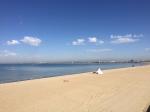Five sun safety tips
21 November 2016
Excessive exposure to ultraviolet (UV) radiation causes almost all cases of skin cancer. We all need to learn about the potentially dangerous effects of UV) radiation and the steps we can take to limit our exposure.
Two UV misconceptions: temperature and shade
Ultraviolet (UV) radiation levels are not linked to temperature. If a cool southerly change has blown through overnight, you’ll still need sun protection even though the temperature might feel a lot cooler than the day before. You can't see or feel UV radiation on your skin.
Sitting under a shade structure for long periods might protect you from the direct effects of the sun, but you’ll still be exposed to UV: If you’re sitting on the beach you’ll get an extra 20 per cent of UV reflected from the dry sand. On a boat, you'll get an extra 10 per cent reflected from the water, and another 10 per cent reflected from your boat.
Reducing exposure to UV radiation
The Cancer Council has five key recommendations for reducing exposure to UV and preventing skin cancer.
- Slip on sun protective clothing that covers as much skin as possible. Wear shirts with long sleeves and collars, and longer style shorts and pants.
- Slop on SPF 30+ sunscreen. Apply 20 minutes before going outside and reapply every 2 hours. Don’t forget to protect your legs from reflected UV.
- Slap on a hat. Broad-brimmed, bucket and legionnaire styles offer the best protection.
- Seek shade whenever you are outside, and make use of portable shade structures where possible.
- Slide on sunglasses. Eyes need protection from the UVR too.
Daily weather forecasts from the Bureau of Meteorology contain 'Sun protection times' in line with the Cancer Council's recommendations. For example:

More information on UV safety
- UV and sun protection times: Graphical and text forecasts of maximum UV and recommended sun protection times for Australian coastal locations, and a UV index forecast map covering the Australian continent and surrounding seas, from the Bureau of Meteorology.
- UV data: Real-time UV readings for capital cities, from ARPANSA.
- UV and sun protection: Advice on proper application of sunscreen, a sunscreen calculator, and detailed sun protection information from the SunSmart website.
- Guide on exposure to solar ultraviolet radiation: Sun protection for outdoor workers, from Safe Work Australia.


Comment. Tell us what you think of this article.
Share. Tell others.